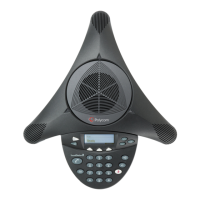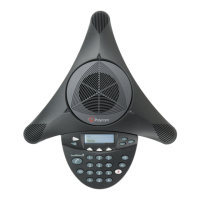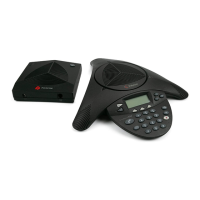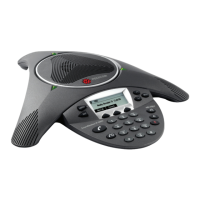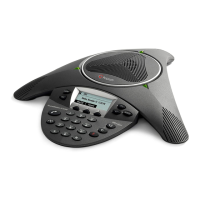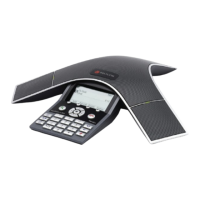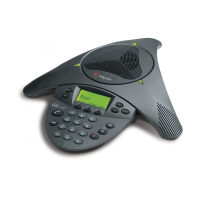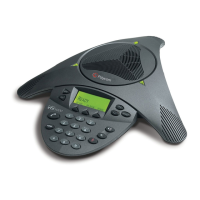Do you have a question about the Polycom SoundStation2 and is the answer not in the manual?
| Microphone Coverage | 360 degrees |
|---|---|
| Connectivity | Analog |
| Full Duplex | Yes |
| Connectivity Technology | Wired |
| Speakerphone | Yes |
| Microphone | 3 cardioid microphones |
| Echo Cancellation | Yes |
| Noise Reduction | Yes |
| Power Source | AC power adapter |
| Display | LCD |
| Dimensions | 14.5 x 12.25 x 2.5 inches |
| Weight | 1.75 lbs |
| Frequency Response | 300 Hz - 3.3 kHz |
| Microphone Pickup Range | Up to 10 feet |
| Compatibility | Analog phone lines |
| Warranty | 1 year |
| Ideal Room Size | Small to medium rooms |
Polycom's legendary technology for automatic voice pickup.
Backlit LCD and soft keys for easy operation, with CallerID and phonebook.
Select display language from multiple options for user comfort.
Connect extension mics or mobile phones for expanded range and functionality.
Connecting the device and initial setup procedures.
Display message upon power up and after call completion.
Visual status indicators for call progress, incoming calls, mute, and hold.
Overview of device buttons including Menu, Exit, Soft Keys, Phone, Conference, Mute, and Dial Pad.
Explanation of the LCD screen layout including Information Area and Soft Key Functions.
Methods for initiating and answering calls, including handling second calls.
How to terminate an active call using the Phone key.
Placing calls on hold and muting the microphone during a call.
Monitoring call progress and redialing the last number.
Adjusting ringer, dial tone, and speaker volumes.
Adjusting the contrast of the LCD display through the Settings menu.
Selecting and sampling different ringer types via the Settings menu.
Turning the LCD display's back light on or off through the Settings menu.
Selecting the preferred language for phone display information.
Using the SoundStation2™ as speaker/mic for a mobile phone or for calls without analog lines.
Establishing multi-party calls by using the Conference button.
Procedure to add a second call to an active conference call.
Programming a conferencing bridge number for quick access.
Placing calls directly to a programmed conferencing bridge.
Storing and managing up to 25 contacts in the local directory.
Methods for quickly finding contacts by name or speed dial.
Steps to add new contacts to the phone book with name, number, and company.
Modifying existing contact details and removing contacts from the phone book.
Accessing device location, number, and system details.
Diagnosing and resolving problems with dial tone and incoming calls.
Troubleshooting flickering LCD screens and non-responsive keypads.
Improving audio quality for muffled or distant speech.
Tips to avoid audio disruptions and procedures for physical damage.
Guidelines for optimal placement, usage, and cleaning of the SoundStation2™.
Overview of the Admin Setup menu options including Location, Phone System, Passcode, and Diagnostics.
Assigning, removing, and changing passcodes for administrative access.
Setting the physical location name and associated telephone number.
Configuring Caller ID and Flash Timing for the phone system.
Performing microphone/speaker tests and restoring factory default settings.
Polycom's warranty terms for product defects, including repair, replacement, or refund.
Conditions under which the limited warranty does not apply.
Information on obtaining service agreements from Polycom Authorized Resellers.
Limitations on warranties, damages, and governing legal statutes.
Device compliance with FCC Part 15 rules for radio frequency interference.
Notice regarding compliance of digital apparatus with Canadian ICES-003.
Equipment compliance with FCC Part 68 and labeling requirements for telephone companies.
Understanding the REN for determining the number of devices on a line.
Guidelines for emergency dialing and information on telephone connectors.
Requirements for connecting certified equipment to Canadian telecommunication services.
Details FCC registration, REN, FIC, SOC, and USOC for customer reference.
Indicates compliance with EEC directives for CE marking and TTE Directive.
Polycom's declaration of compliance with essential requirements of Directive 1999/5/EC.
Notices regarding mains powered telephony and VCCI Class B compliance.
Table guideline for selecting the correct Caller ID standard based on country.
